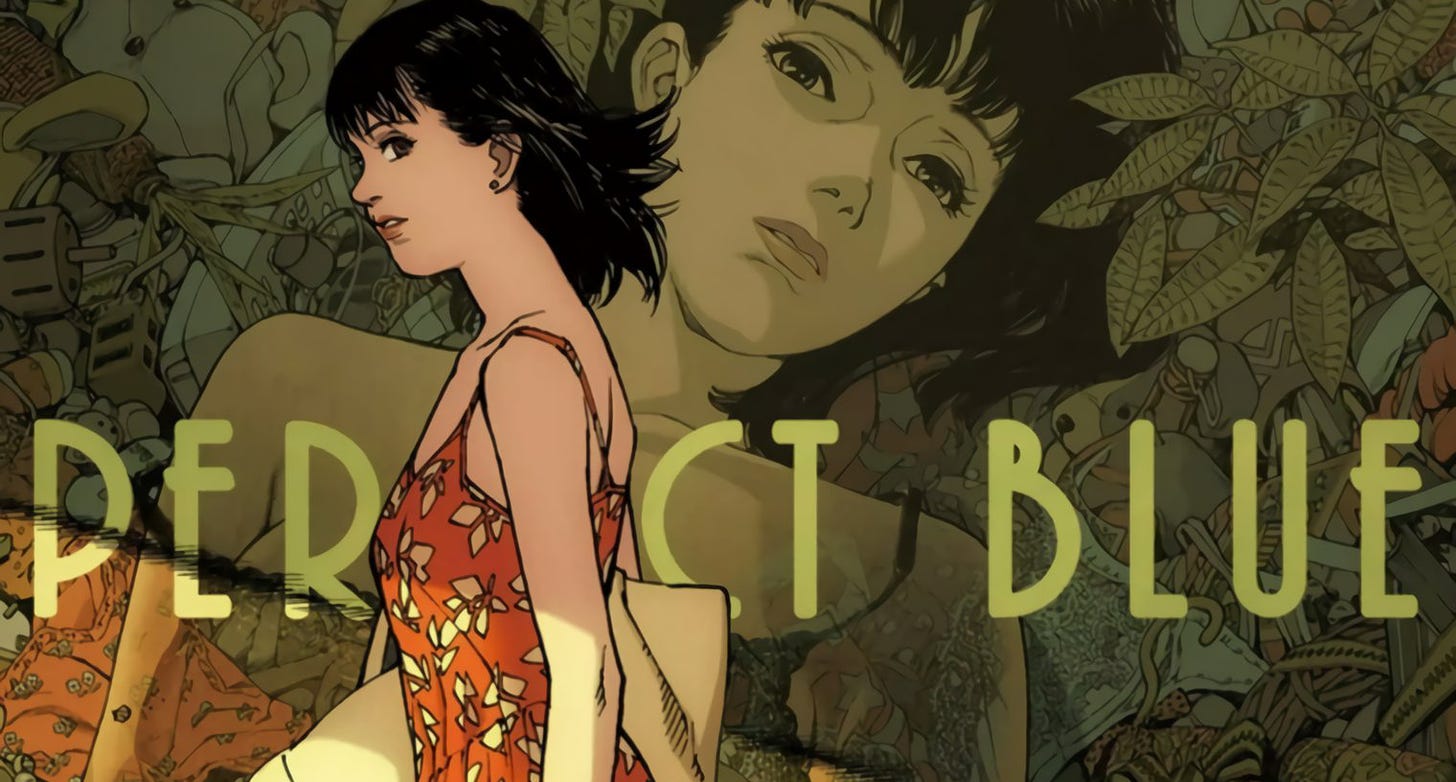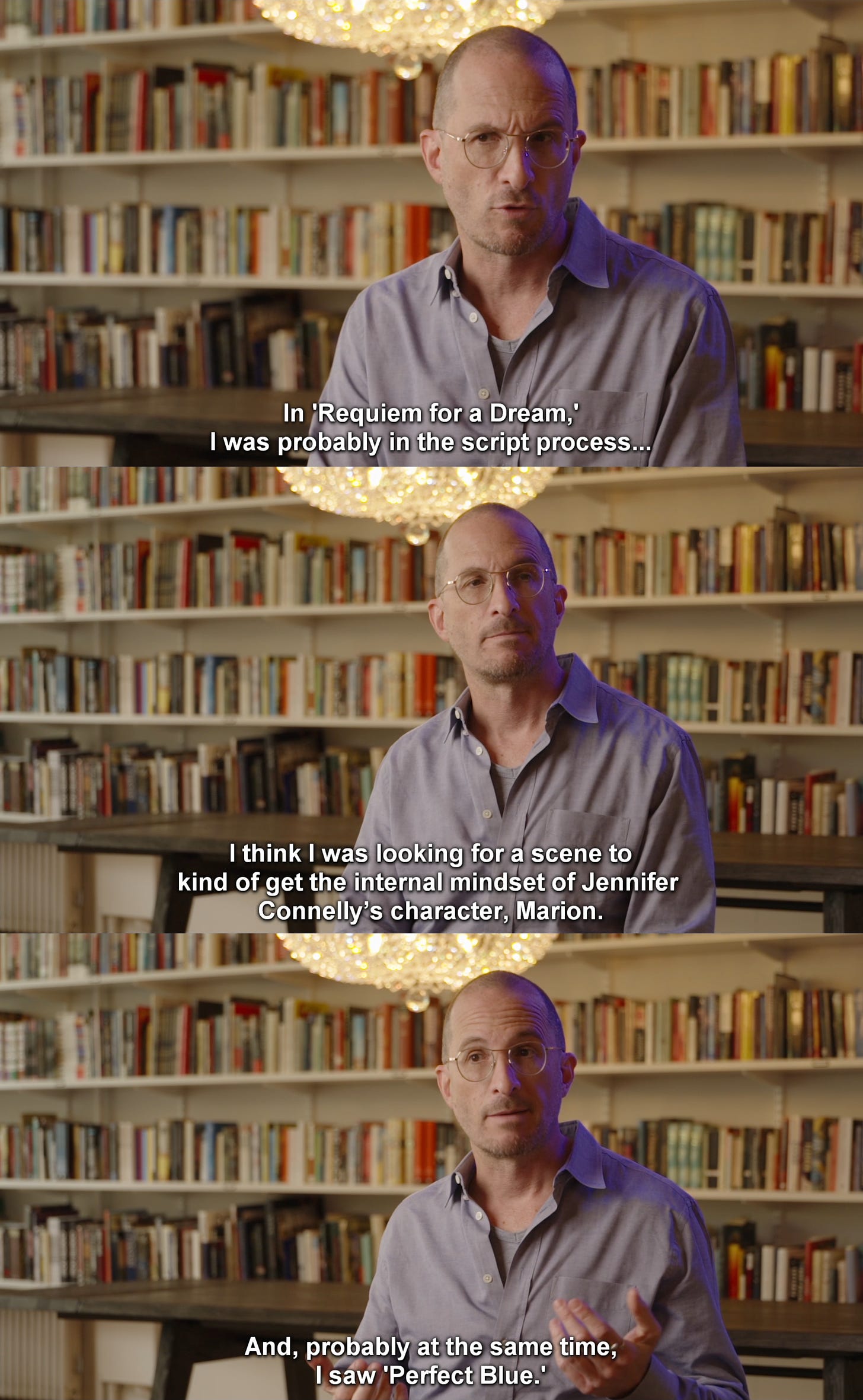Welcome to another issue of the Animation Obsessive newsletter! Here’s what we’re doing today:
1 — Satoshi Kon v. Darren Aronofsky, in detail.
2 — this week’s animation news, around the world.
We publish every Thursday and Sunday. If you’re new here, it’s free to sign up for our Sunday issues — they’ll land right in your inbox, every week:
That’s enough of that — here we go!
1. “Too much homage”
At this point, the similarities between Darren Aronofsky’s Requiem for a Dream (2000) and Satoshi Kon’s cult anime classic Perfect Blue (1997) are common knowledge.
You’ve likely seen a few of the side-by-side comparisons. They’ve circulated for years. Each time they reappear, there’s another small uproar — and old rumors pop up again, like the one where Aronofsky supposedly owned the rights to adapt Perfect Blue (he didn’t).
That said, we’re not here to restate the obvious. Perfect Blue and Requiem for a Dream are similar, but we’re interested in the follow-up questions. Why? What really happened between Kon and Aronofsky? And when does homage stop being respectful and start being exploitative?
We’ve chased down the answers for months — dredging up every source we can find, and even importing the recent French documentary Satoshi Kon: The Illusionist. (A tweet thread by Richmond Lee of Art Eater was also a big help.) Today, we’re using what we’ve learned to set the record straight.
So, let’s take a trip into the past — to the turn of the 21st century.
Once upon a time, Satoshi Kon was a no-name. Just another artist struggling in manga during the ‘80s. Yet the talent was there, and it carried him. Becoming Katsuhiro Otomo’s assistant on the manga series Akira, Kon was able to follow Otomo into the anime industry.
Kon hopped around as an artist and writer, working on projects like Roujin Z (1991) and Magnetic Rose (1995). He climbed the ranks until he got to direct his first feature. That was Perfect Blue — a film that, despite glowing reviews, did little to elevate Kon in the business. Here’s how his colleague Masao Maruyama put it:
Let’s say that some said it was an original film, that it was very striking, and that it left a strong impression. We can’t say that the animation industry considered it a very good film […] we did not cover our costs.
Basically, Perfect Blue flopped. Kon was, as he later described himself, an “unsuccessful animation director.” But his film struck a chord with another artist, an ocean away.
Darren Aronofsky was an anime fan — and a budding director. He’d just debuted his first movie, Pi (1998), which had a much lower budget than Perfect Blue but made much more money. So, Aronofsky was working on his next film. This was Requiem for a Dream, based on a book from the 1970s by Hubert Selby Jr.
Aronofsky found Perfect Blue while writing the script. “I was blown away by it — it was fantastic,” he remembered in The Illusionist. “And it was very different than any other anime that was out there that I had seen.”
At that time, many live-action directors in America were taking from anime. It was often treated as raw material. When Terminator 2 borrowed a moment from Akira, one of James Cameron’s artists recalled that Otomo’s original visual was “almost like a storyboard” for the team. The Wachowskis pitched The Matrix by playing their producer Ghost in the Shell. As he recounted:
… they said, “We wanna do that for real.” And, you know, that was an incredible idea. To actually see that animation come to life. And, believe me, essentially it has.
Aronofsky was so smitten with Perfect Blue that, at one point, he even tried to buy the rights to do a live-action remake. That deal never went through (Aronofsky has given various reasons why over the years). Either way, the film influenced him.
Most of the events in Requiem for a Dream derive from Selby’s book — a disorienting, stream-of-consciousness story about addiction and despair. But Aronofsky also incorporated ideas from Perfect Blue, most famously the scene where Jennifer Connelly’s character screams underwater in a bathtub. He remembers reaching out to Kon for permission, although we haven’t seen Kon mention this.
Kon, for his part, was shocked when he saw Requiem for a Dream. In the early 2000s, he told the readers of his blog, “There are scenes in Requiem that were heavily influenced by Perfect and shots that were copied in their entirety.” He singled out the tub scene, but didn’t stop there. The shared motif of the red dress drew his attention, too.
Then, on January 18, 2001, the two directors met.

It was a conversation at a hotel, hosted by Esquire to promote Requiem for a Dream. They spoke through an interpreter. Kon attended partly to advertise his second film, Millennium Actress. He and Aronofsky followed it with food at a Thai restaurant.
Aronofsky was overjoyed. “I will never forget the meal I had with Satoshi Kon in Tokyo. He was incredibly generous and warm. For a fan, it was a huge thrill,” he later wrote. He said that he asked Kon:
… what he thought of the [tub] shot, and he said he was very proud. So, it was great. It was a lot of fun to have that kind of connection with him.
Kon’s view of their conversation was a bit different. “When I was told upon meeting him that he was a fan,” he wrote on his blog, “all I could do was respond with the vague smile that Japanese people are good at.”
Regarding the shot, Kon broached the subject by telling Aronofsky, “I was a little embarrassed to see scenes in Requiem that I had seen somewhere before.” Aronofsky replied that he was paying homage.
As Kon’s former colleagues repeatedly say in The Illusionist, Kon had two sides. One side was endearing. Kon could be supportive and courteous. Aronofsky saw that part of him. Yet, at other times, Kon could be vicious. He burned bridges. Many of his closest co-workers, even those who remember him fondly, have described him with the phrase iyana yatsu. “Nasty guy.”1
Kon revealed a bit of this side on his blog after the meal, ribbing Aronofsky and suggesting that Requiem had ripped off Perfect Blue. He wrote that Aronofsky was paying “too much homage.” But his claws weren’t totally out, and he treated Requiem for a Dream as mostly benign. Kon was much angrier when he recalled the meeting in 2007, during a lecture:
Satoshi Kon: When I asked him about it, he said it was an homage. (laughs) An homage to me! To me! And who’s doing this scene in Requiem for a Dream? Jennifer Connelly. She’s doing this scene. Just like in my storyboard! (laughs) As a side note, last year I was on the same flight as Jennifer Connelly. She was in first class with her entire family; I was in business class. So she got off the plane first.
Runa Nagai: So you didn’t get a chance to talk to her?
Satoshi Kon: No, you can’t go, “Hey, Jennifer! Damn you, you copy-catted me.” Well, not like she was the one who did it.
In part, his feelings were understandable. Aronofsky was a star by this point, while Kon was scrambling for funding. Pi was a hit, and Perfect Blue wasn’t. That pattern played out again with Requiem for a Dream and Millennium Actress. Although Requiem for a Dream isn’t to Perfect Blue what The Matrix is to Ghost in the Shell, you can still feel Kon’s influence in it.
You feel it especially in the Connelly character, whose arc later in the movie takes cues from Mima, the protagonist of Perfect Blue.
It’s in the tub scene. It’s in the scene where Connelly trashes a room. And what happens to Connelly’s character in the final moments of Requiem for a Dream is a close paraphrase of, arguably, the central sequence in Perfect Blue — from the blinding lights to the cheering men around the table. Unlike most of Requiem for a Dream, for the record, this scene is noticeably absent from Selby’s original book.2
At least for the last leg of Requiem for a Dream, it’s clear that Aronofsky saw in Perfect Blue a source of inspiration for what to do with Connelly’s character. Ultimately, it’s a small slice of the film. But it’s still a slice.

Pointing out that Aronofsky took from Perfect Blue is different from condemning him for it, although you can do both. After all, every piece of art takes from somewhere. Kon was open about how much he learned from foreign filmmakers like Terry Gilliam. Meanwhile, Perfect Blue’s film-within-a-film Double Bind plays much the same role in its story as Invitation to Love does in Twin Peaks (a series that went big in Japan).
At the same time, though, there’s an ethical question.
Until the end of his life, Kon was a struggling director. Even after two acclaimed films, he was so unsuccessful that Tokyo Godfathers almost didn’t get funded. Is it still an homage when you’re lifting from an immediate contemporary who’s far below you in status and clout? As Kon wrote in 2001, after meeting Aronofsky:
I’m feeling pathetic. It’s a pitiful tale when the person being paid homage to has less name recognition, less social credibility and less budget to spend.
Again, most of Requiem for a Dream comes from Selby’s book. Even the motif of the red dress and the moment when people pop out of a TV, which Kon perceived as plagiarism, are Selby’s ideas from the ‘70s.3 Requiem for a Dream isn’t Perfect Blue. But it does treat its ideas as fair game.
Aronofsky seems to have been a fan, first and foremost. He loved anime, and he loved Kon’s work. The culture of swiping from anime in American cinema predated him. It persists now. As Rodney Rothman (Into the Spider-Verse) says in The Illusionist, “A lot of people in live-action are chasing the ‘Satoshi Kon feel,’ that level of immersiveness.”
That included Aronofsky himself, later in life, when he took from Perfect Blue again to make Black Swan. (He denied it, but come on.)
In the end, the real question we need to ask is much bigger than Aronofsky. It’s even bigger than Kon. The question is, “Is it right for Western directors to use anime as an idea factory, without paying its overworked creators a dime?”
Kon bled for his films. He storyboarded every moment in detail, obsessively, and still never saw success in his lifetime (he died in 2010, around a week before the premiere of Black Swan). It stung him to see his concepts treated as the rough drafts for other people’s films. He battled to create those concepts, until the end.
Looking back on their meeting for his interview in The Illusionist, Aronofsky remembered:
[It] was kind of inspiring to find out that he was conceiving it, drawing it, writing it, so many of all the different roles were basically coming out of his imagination and the hard work. I remember kind of feeling empathy for how much work he had to do. That it was gonna be a lot of pain, a lot of work to get his film done.
2. Global animation news
The state of animation in wartime
The world of Russian animation isn’t heading in a great direction.
As we’ve reported, the global sanctions and boycotts on Russia, designed to pressure Putin into ending his horrific invasion of Ukraine, have touched Russia’s animators. This week, the Russian Animated Film Association (AAKR) offered an update:
… the current situation in the world has most painfully affected international relations in the field of animation and culture in general. We see how many of our partners from Europe and the United States refuse to cooperate, terminate existing agreements and block Russian-made children’s content. Our films are not taken to international festivals or are asked not to mention that they are from Russia.
The AAKR ended with a plea to the world that “cultural cooperation has no and should have no borders.” As a new Iron Curtain settles around Russia, that view seems increasingly of the past.
The animation business in Russia is shrinking inward. Take the upcoming film Finnick. It just got signed to a distributor owned by Gazprom — after Sony Pictures dropped its previous distribution deal. As Western companies back out more and more, like Paramount and Disney did this week, the Russian animation industry will be trapped increasingly in Russia.
And the country is leaning into this isolation. Dismissing a copyright lawsuit, the courts just granted an “entrepreneur” named Ivan Kozhevnikov the right to plagiarize Peppa Pig. As one American lawyer writes, “I would expect Russia’s efforts to steal Western IP to intensify in the coming weeks.”
Meanwhile, domestic social media platforms VK and OK are booming, as Russians lose access to Western-made ones and VPN services get harder and harder to find. For a limited time, VK is reportedly giving 100% of ad revenue back to creators — which includes animators who share their work on the service.
That rush to fund artists is happening at the government level, too. New rules, rolled out this week, make it easier than ever to get state funding. Before, studios needed to put up anywhere from 50,000 to 1 million rubles as collateral to apply. Now, it’s free.
At the same time, the world continues to support Ukraine directly. Artists are running “free film screenings for children and families at refugee reception centers near the Polish-Ukrainian border and throughout Poland.” Streaming platforms in Germany and Poland are providing free Nickelodeon shows to Ukrainian refugee children. And France is rolling out a new fund for Ukrainian artists — and for Russian opponents of Putin who’ve fled their home country.
This week, the French outlet La Croix spoke to animator Eugène Boitsov, a Ukrainian immigrant in Valence who’s helping refugees in his area. Asked about the animation world’s protests in support of Ukraine, he was torn. Part of him thinks they’re useless. But another part believes that they matter.
“Art and animation will especially be very useful when Ukraine wins,” Boitsov said, “to help rebuild the country.”
Thanks for reading so far! The rest of today’s issue is for paying subscribers (members).
Running the Animation Obsessive newsletter is costly, both in time and money. Each and every member is key to keeping it going. In exchange, they get a ton of exclusive material.
Our recent dive into the underrated Princess Arete is one example. It shows how director Sunao Katabuchi rose up after struggling for years in the anime industry — even losing his director role on Kiki’s Delivery Service. The article is loaded with rare details, many of which haven’t appeared in English until now. It’s an exciting story.
Below, we finish rounding up the news in our usual “best of the rest” segment, with newsbits and opportunity listings from America to Tenerife, and beyond.
Members, read on. Everyone else — see you next week!
Keep reading with a 7-day free trial
Subscribe to Animation Obsessive to keep reading this post and get 7 days of free access to the full post archives.





